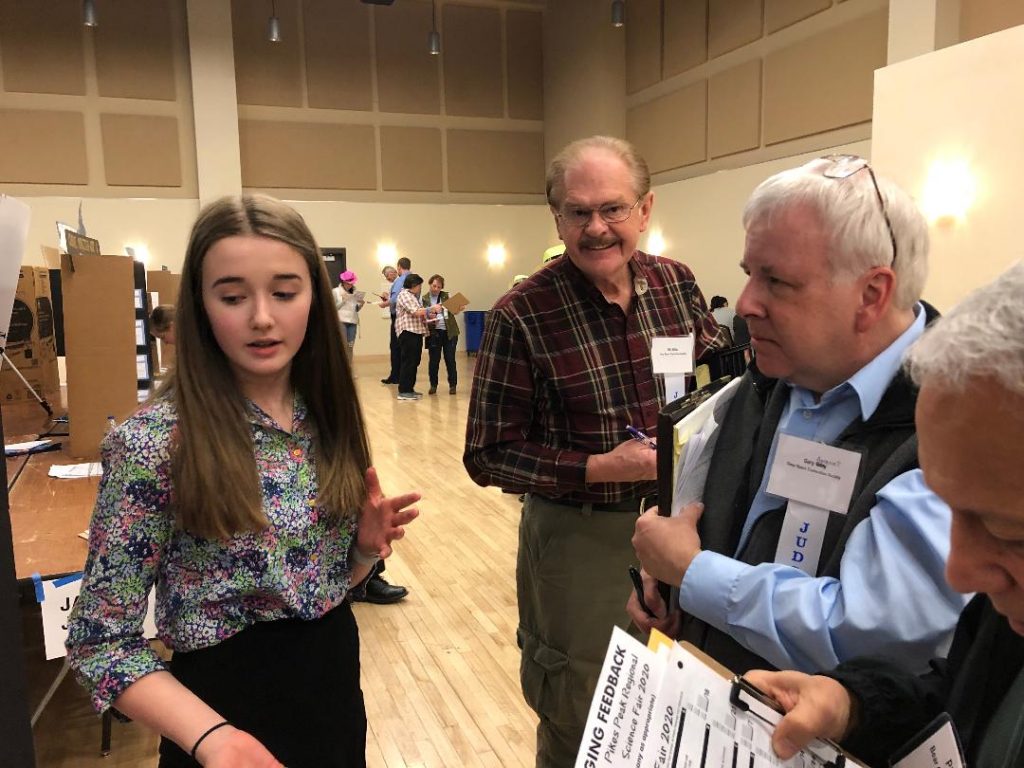This is a summary of the work done at the Plishner Radio Telescope site on June 20, 2020. Written by Bill Miller.
http://dses.science/wp-content/uploads/2020/06/Plishner-site-trip-summary-of-6-20-20.pdf
Deep Space Exploration Society
Colorado — Radio Astronomy at the Speed of Light
This is a summary of the work done at the Plishner Radio Telescope site on June 20, 2020. Written by Bill Miller.
http://dses.science/wp-content/uploads/2020/06/Plishner-site-trip-summary-of-6-20-20.pdf
Hosted online by Dr. Richard Russel.
The slides for the meeting are available here on PDF: http://dses.science/wp-content/uploads/2020/05/DSES-Science-Meeting-5-25-2020-r2.pdf
The link to the video of the meeting is at the end of this page.
*
Notes of the May 25, 2020 Science Meeting are by Bill Miller:
We had 12 participants in the virtual science meeting:
Dr. Rich Russel, Ray Uberecken, Myron Babcock, Ted Cline, Jon Richardson KU4PEH, Ed Corn, Gary Agranat, Bob Haggart, Jim Madsen K3ILC, Dave Molter, Bill Miller
Preliminaries:
Rich thinks we need Internet service at the site for some of the experiments.
When Rich and Ray went down this last weekend the transformer at the gate had blown and they had to call in the power company to come fix it so didn’t get anything else done. The power company came down, worked on it, and got it fixed.
Bill, we need to mention that everyone should read our policy on meeting and going to the site on the webpage. If you have had the virus or have had symptoms or been exposed to a positive person you should self-isolate from the group and others for 14 days and not meet of go to the site.
Rich is the SARA east conference coordinator. The August conference is virtual and is $20 to participate. http://www.radio-astronomy.org/node/279
We were placed on the Neutron star group for the pulsar observation that Rich, Ray and Bob made several weeks ago. Rich thanks the rest of the group for all the hard work that got us to this point.
http://neutronstar.joataman.net/sites/dses/index.html
Rich’s presentation:
Rich gave his presentation on Pulsar B0329+54 observation, software setup and capture.
The Presto SW builds a .FIL file with the data and time stamp.
Initial trial runs in Feb and May had the gain set too high and was saturating the receiver.
The first thing to check is the signal level of the feed and amps on a spectrum analyzer.
The site has a lot of RFI at 408 MHz right where we would like to observe so have to move up from this.
Ray added a 20dB preamp at the trailer end of the feed line.
Will move this preamp to the antenna end to compensate for the coax loss and reduce noise.
Single frequency RFI signals are filtered out by the SW.
The manual tracking works really well.
The tracking is run on the control Laptop and the Presto SW is run on the Linux Laptop.
The Initial .FIL file gave a 2 pulse display after folding the signal from several hours of data.
The Presto SW is at www.cv.nrao.edu/~sransom/presto
The SW needs input of a very accurate pulsar period. The doppler error in the period due to the rotation of the earth and its orbital velocity and position in orbit, also modifies the perceived pulsar period. Need to have the pulsar period set out to 4 or 5 decimals for the SW to fold/stack the signals to a usable observation.
The new SW takes the data, time tags it with the GPS data and creates the .FIL file.
The data from the Presto program will give a signal strength vs time for a single pulse that can be plotted using excel. This Pulsar has a W50, 50% of pulse height with width of 6.6 mSec
This pulsar is circumpolar so it can be acquired at any time of day. We need to change the mount limits to better enable this tracking without having to stop and unwrap 360 degrees if near the stop.
Most of the other available pulsars are in the Milky Way and only visible at night at this time of year.
The Murmur SW http://i0naa.Altervista.org is a good tool to find the pulsars
For low horizon pulsars with little access time, perhaps you could add the sample files from several days together to get more data and stacking strength to acquire the signal.
Scintillation is a problem that distorts the signal through the atmosphere so we need observations that are high in elevation and at the best times of day and night for atmospheric stability.
The next observing session is planned for coming Friday night or through Saturday.
We need to get at least 5 pulsars to get on the top of the neutron star list.
Jon asked, “Where is the pulsar capability going?”
Badge of honor and accomplishment.
One of the difficult things we have the facility to do.
Finding a glitch in the pulsar.
There are guys that process pulsars daily and look for anomalies.
Ray has his new quick change feed on the dish.
We can do pulsars for several months and then do EME or can receive the beacon from the moon.
https://www.google.com/search?q=OE5JFL+beacon
With Rays quick change feed, we can switch back and forth.
We can do Skips SETI observations in between other work with simple change out of the feeds.
We need a group calendar or way to communicate on the web site to schedule site trips and who is going. Need to find a way to do this.
The Zoom Meeting Recording can be found on my Drop Box link at:
https://www.dropbox.com/sh/l949mj9o2084nhs/AACnrJNys-jzNa-mwzSfG4eka?dl=0&preview=2020-05-25+Science+Meeting.mp4
Please forgive the first 5 minutes of setting up Zoom.
by Bill Miller 5/11/2020
We had 17 participants in the virtual engineering meeting today: Most ever! Thanks everyone for joining.
Participants: Dr. Rich Russel, Ray Uberecken, Myron Babcock, Ted Cline, Bob Sayers, Jonathan Ayers, Xander Duvall, Tony Bigbee, Ed Corn, Gary Agranat, Skip Crilly Don Latham, Glenn Davis, Floyd Glick, Matt Mathews, Bob Haggart, Bill Miller
Agenda and notes:
Open Floor
Bill recorded the meeting on Zoom. It is in two parts, due to a gap in Internet coverage:
Bob Haggart (N0CTV) has been steadily improving the workspace of the science trailer at the Plishner radio telescope site. During the pulsar observation work on May 2, 2020, he completed building his latest enhancement: a partitioned work space at the east side of the science trailer. There is desktop space, which can be used for electronics building and testing. And there is additional shelf space, for better organization and storage.
Thank you Bob!

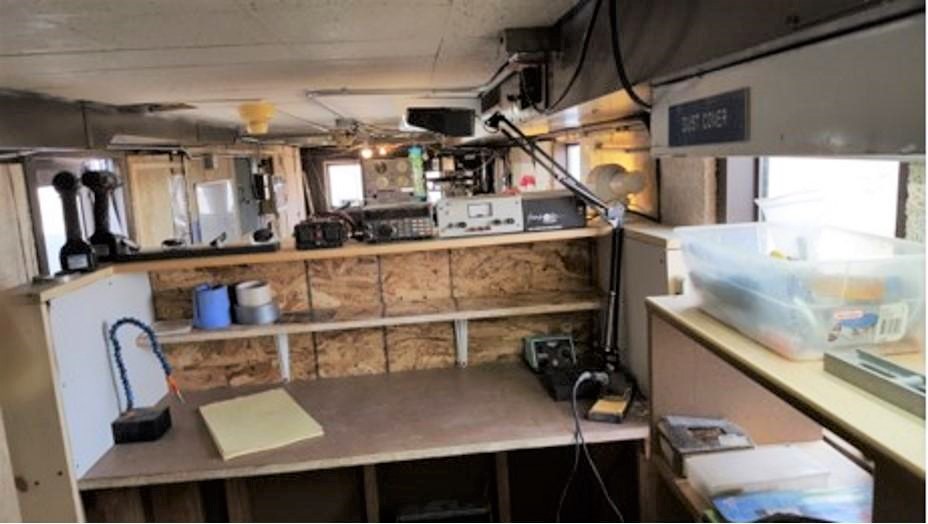
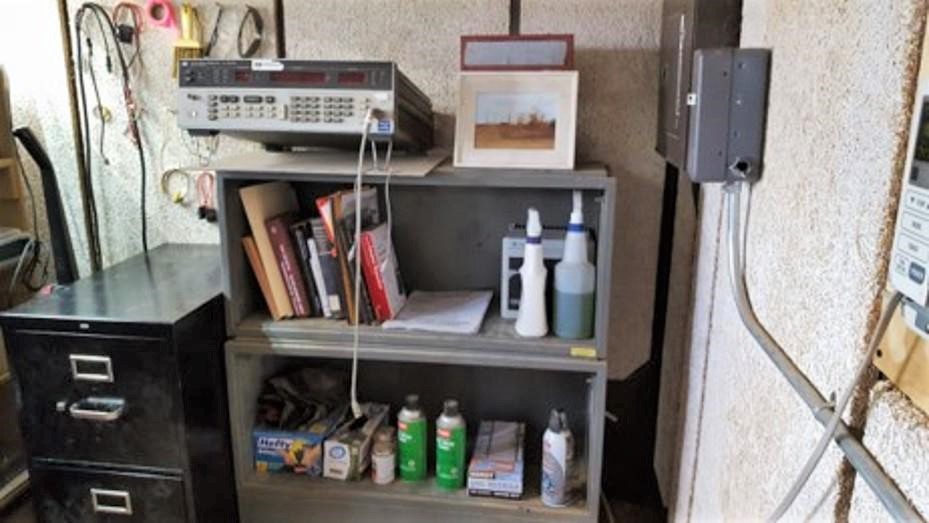


By Dr. Richard Russel, DSES Science Lead.
The pulsar, B0329+54 (J0332+5434)1, was observed on the third try just before the team was ready to pack up for the day on Saturday, May 2, 2020. A final modification of the software defined radio settings was tried (all the gains were set to a minimum) did the trick.
The 60-ft dish was setup to manually track the pulsar using the System 1 tracking program software developed by Glenn Davis and Phil Gage. This program allowed us to track the pulsar’s position by keeping it in the bullseye.
We observed at a frequency of 420 MHz, with a bandwidth of 10 MHz.
The pulsar system was initiated last year by Steve Plock. Our mentor throughout the effort has been Dr. Joe Martin (K5SO) in New Mexico. Joe validated that we made a successful pulsar capture.

The GNU radio software was turned on to start the acquisition.

It should be noted that you cannot tell if you have the pulsar real-time because it is pulsing way below the noise level. After about 30 minutes, we stopped the acquisition and we moved the post-processing over to Bob’s new workbench.


Rich and Ray celebrate our first pulsar! (Bob’s taking the picture)

The first iteration of post -processing requires that the pulsar period be estimated with a program called TEMPO. The first iteration is shown below. It clearly shows a pulsar because of the prominent peaks and the lines tracing down the plots, however it is not quite set to the optimum period.
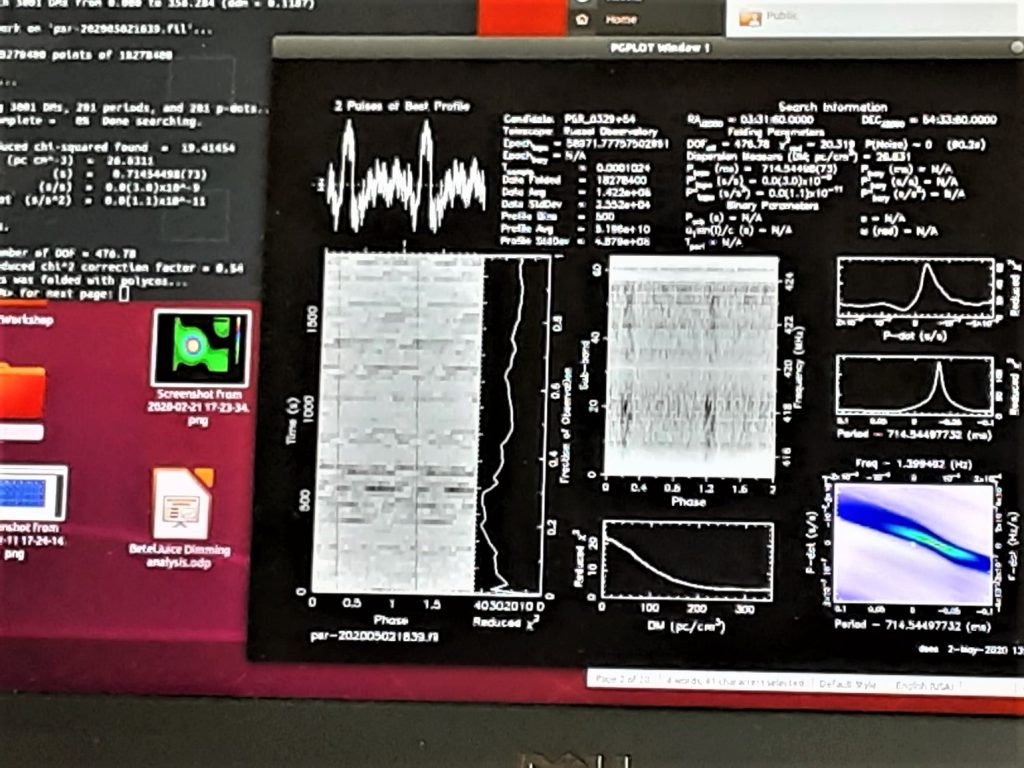
After some more iterations the final picture looked cleaner.

More analysis using the resultant data files allowed us to verify the pulsar as B0329+54 (J0332+5434).

Even the pulse width at the 50% height (W50) was estimated. The preliminary analysis below shows a measured W50 of 6 ms. The current value in the ATNF database is 6.6 ms. This is real close and confirms our observation.
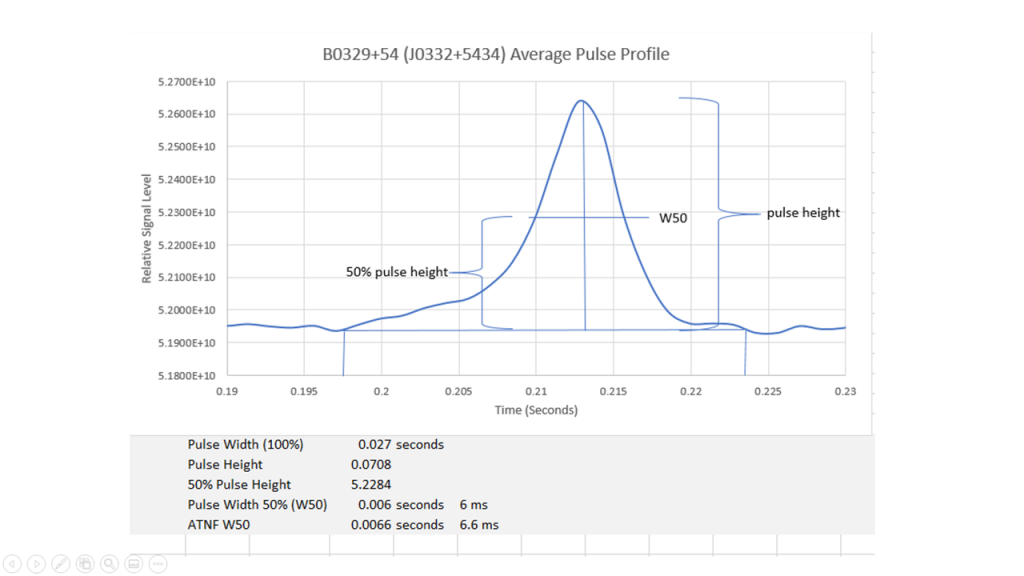
More observation runs are planned and DSES can can consider itself one of the few amateur organizations to accomplish pulsar observations2.

Reference:
Meeting notes by Bill Miller, April 29, 2020.
We had 13 participants in the virtual science meeting:
Dr. Rich Russel, Ray Uberecken, Myron Babcock, Ted Cline, Bob Sayers, Jon Richardson, Jonathan Ayers, John R Kucypeh (sp), Xander Duvall, Tony Bigbee, Ed Corn, Gary Agranat, Bill Miller.
Ray gave a discussion of feed system modifications and plans fix the feed to enable Pulsar work.
Bill said we have to hold a virtual board meeting and elect officers from the board. We also need to call the annual all members meeting.
Rich gave a presentation with slides (see below) on reduction and graphing of data sets from the national observatories and Pulsar observations. He also discussed the data from his 9 foot dish and about how to understand the Hubble Galaxy and object classification nomenclature, such as MG0424+0435 where 0424 in the right ascension and +0435 is the declination. He also discussed the gravitational lensing effect given by the gravity well of a foreground object bending the light and radio emissions of a background object around it. Prime examples of this are; https://www.eso.org/public/images/eso9856f/ and https://en.wikipedia.org/wiki/Einstein_Cross the Einstein Cross. Rich gave data and discussion of the Betelgeuse dimming phenomenon and whether this may be preamble to the star going supernova. While a supernova may be preceded by a few hours by an early warning detector of Neutrinos as Gary has outlined, it is unlikely that this is the cause of the dimming and Rich gave a discussion of his theory and simulation of a passing object shading Betelgeuse.
Xander Duval was in attendance and said that he had been invited to go to the state science fair when others dropped out. At the Fair he won an award from Nasa on earth science systems and submitted his research paper to the Junior Humanities and Science symposium and scored another award in physical sciences there. We are happy that this worked out well and hope to help him with future work.
Bob Sayers has a 4 ft PVC Mag Loop antenna that he would like to give away. This can be configured for use with a SuperSID setup.
Rich said that it can be used as part of the Astronomy League’s Silver/Gold certification for radio astronomy. You need 5 projects, 2 of which you need to build yourself. Available projects are:
Jonathan Ayers has a paper up on the SARA Western Conference Proceedings. Gary Agranat says check it out at http://dses.science/wp-content/uploads/2020/04/MitigateRFIinSCDriftScanDataPython.pdf [Python Program for Mitigating Radio Frequency Interference Observed in SpectraCyber Receiver Drift Scan Data Files, by J. Ayres]
Here is a drop box link to the meeting recording missing the first 10 minutes before I logged in.
https://www.dropbox.com/sh/2pqscwj7txr7d5p/AADq0yNlG2KI3ZZDE8lqfxEta?dl=0
These are the slides from our DSES Science Meeting, Monday evening April 27, 2020. Presented by Dr. Rich Russel. In PDF format.
By Glenn Davis
I thought I would put out a System 1 status, so you can see what we’ve been working on the past couple of months. To quickly summarize: Lewis Putnam has been concentrating on the System 1 hardware design (Please see the hardware diagram below) to support automatic tracking of the Haswell Mount. Additionally he has been looking at the individual mount axis characteristics to see how well they can support sidereal tracking (See detail text below).
Phil Gage has supported myself looking at an Elevation axis movement issue we had seen at the site. We found a loose cable on our March 1 trip which appeared to be causing the elevation axis issues. Additionally, Phil has been working on the hardware/software interface for the Labjack hardware (Please see the hardware diagram below). The Labjack hardware, the U3 and JTick-DAC components, will be used to control the mount axis rates.
I have been updating the System 1 Hardware Simulator to support the Numato Relay Board and Labjack U3/JTick-DAC hardware devices. Additionally, I’ve been working on the hardware/software interface to the Numato Relay board. This device will be used to enable the drive controllers and control the direction of the Elevation Axis. Using the work completed by Phil and the Simulator modifications, I’ve been able to test and debug most of the automatic tracking software modifications and simulate the System 1 tracking celestial objects over large periods of time (hours).
Here is a more detail summary of the past work and future work on the System 1 team (Before site modifications are performed, we will present our design work to the DSES Engineering Team):
March 12 2020 Trip
System 1 Mount Drive Interface Hardware Design/Implementation
Please pass this on to other individuals who may be interested.
Thank you.
Glenn Davis
This paper is an updated presentation by Skip Crilly K7ETI about the continuing SETI observation results we’re doing together. The DSES 60-foot dish antenna in Haswell and the 40-foot dish antenna at the Greenbank Observatory in West Virginia have been making simultaneous observations for SETI (Search for Extraterrestrial Intelligence) since November 2017. A third antenna in New Hampshire was added for taking data in December 2019. Simultaneous observing by sites distant from each other helps filter out local radio frequency interference (RFI). Signals observed at each site can then more confidently be identified as non-Earth in origin. This presentation summarizes the results, with additional data from February and March 2020.
The paper is available as a PDF file. Please click to read. Synchronized Multiple Radio Telescope Microwave SETI, by Skip Crilly [HamSCI 2020, March 2020]
This updates the previous presentation of February 2, 2020.
A new article appearing in the April 2020 Scientific American is “A New Map of the Milky Way” by astronomers Mark J. Reid and Xin-Wu Zheng.
https://www.scientificamerican.com/article/a-new-map-of-the-milky-way/
The article describes recent parallax studies, using Very Long Base Line Interferometry(VLBI) radio astronomy in Japan and North America, to more accurately determine the spiral structure of our Milky Way galaxy. The studies indicate also that the Sun is closer to the central plane of the Milky Way than previously thought.
These VLBI studies utilize natural MASERs that are produced by molecules of water and methyl alcohol in ionized regions just outside hot stars. Hot stars are always short lived, not lasting more than a few million years, because they rapidly burn through their nuclear fuel at their higher temperatures. They therefore are found close to their original location of birth. They are one of the features that define a galaxy’s spiral arms. And so to map the location of the hot star MASERS is a means to map the spiral structure of the galaxy. Radio astronomy VLBI enables angular position measurements to high resolution. The angular position measurements are used to measure the parallax over the course of a year, and therefore measure distance to more accuracy. The more accurate determination of angular position in the sky and distance therefore enables a more accurate mapping.
Written by Gary Agranat. Photos by Tony Bigbee.
Bill Miller, Tony Bigbee, and I (Gary Agranat) served last month as judges at the 2020 Pikes Peak Regional Science Fair. The Fair was held at the University of Colorado at Colorado Springs on Saturday February 22nd. Tony served as a general judge, representing the Fair. Bill and I served as special judges representing our radio telescope group, the Deep Space Exploration Society. The Fair is there to encourage students in grades 6 through 12 to explore and develop their interests in science and engineering. The Pikes Peak Regional Fair supports students from Elbert, El Paso, Park, and Teller County counties, whether they are in a school or home schooled.
About $8000 in prizes and special awards are given each year from the Fair and special groups like ours. The Fair prizes are divided into subject area categories, like physical sciences, plant sciences, environment, biomedicine, chemistry, and energy/transportation. There are overall Grand Prizes, and prizes in each of the High School and Junior High School Divisions. Students are also awarded invitations to the State Science Fair.
DSES was one of 43 organizations that sponsored special prizes. This year DSES sponsored 4 awards: 1st prizes and honorable mention awards, for both the Senior and Junior High School student categories. Our 1st prizes included an award of $50. This is our second year judging and sponsoring prizes.
DSES this year also supported a high school student, Xander Duvall, who is interested in astronomy and physics.
Only about 60 students entered this year’s Science Fair, compared to about a hundred last year. Nonetheless, in our opinions, the projects were generally good and well-motivated. One could see the students’ hearts were in it. A number of projects were motivated with real concern for society. Many of the solutions were often quite innovative and truly pushing what had been done before. Even when the projects were not so far reaching, one could tell the students were trying things and learning from their experiences.
Bill and I decided on a 4-part grading system for judging. We wanted to keep this simple, straight forward and manageable, and meaningful. For each student we interviewed, we assigned a grade of 1 to 5 in each of these major areas:
We then used our grades as guides to holistically assess all of the students afterwards. In 5 to 10 minutes of interviewing each student, and looking at their work and presentations, it is a challenge to get an objective view of the full work. The quieter time afterwards gave us time to reflect more fully, and let impressions that were working in the background contribute and give us a fuller answer.
Our goal was to support the young people in developing their quality in all 4 of those areas. I think Bill and I were satisfied with the awards we decided on. There were many excellent projects and several of those were outstanding. We were special judges in our own defined special category. We couldn’t award to everyone that we thought worthy. But in our decisions, we indicated the strengths and qualities we wanted the young people to continue to develop for themselves. We interviewed 7 students in the Junior High School Division and 7 students in the Senior High School Division. We were impressed with and proud of all of the students we interviewed.
We decided on these awards:
Xander was the student we supported. He had come to us just earlier this year. We discussed with him his interests and what we were doing. We only had enough time to provide him with some data, to try to analyze and understand. The data we gave him was from a drift scan with our 60-foot dish of the 21 cm HI hydrogen spectral signal, scanning across the center of our Milky Way galaxy. Xander was able to research the background and develop a sharp presentation with some good explanations and illustrations. We hope Xander will continue to explore and develop his experience with astronomy research. He got a good start, and there is potential for lots of good solid work. Meanwhile, Xander earned several other awards at the Fair: the NASA EARTH System Science Award, the Northrop Grumman Special Awards in Science and Engineering (Sr.Div.), and the Senior Division People’s Choice (which is a popular vote by everyone who attends the Fair).
Additional DSES members helped Xander, including Rich Russel in supporting him with the observational data.

These are the students we interviewed.
In the near future, Bill and I plan to meet over coffee and assess our lessons learned. We’ll think about how we did, our criteria, and what we want to do going forward for the next science fairs, for supporting the young people in developing their work, and in judging at the fairs.
The Science Fair has a website. Pikes Peak Regional Science Fair. There you can learn more details about the Fair and the awards. They also have a nicely done video that highlights the students with their presentations and the experience of participating in the Fair. https://vimeo.com/393350748 The times in brackets in our above list of the students we interviewed are when they appear with their presentations in the video.
